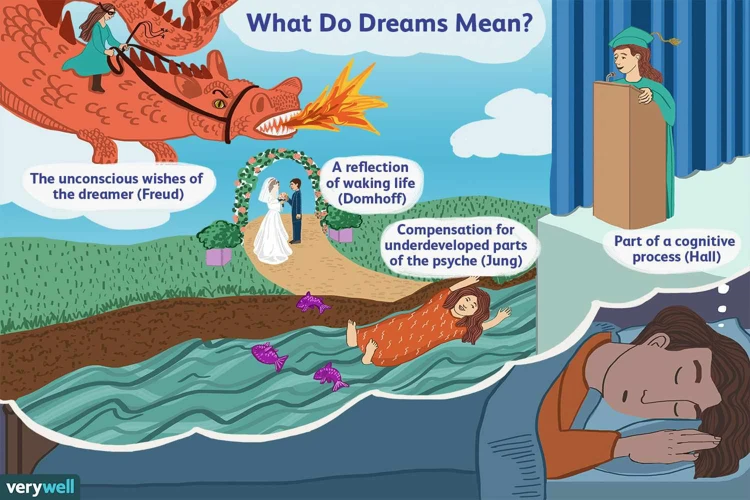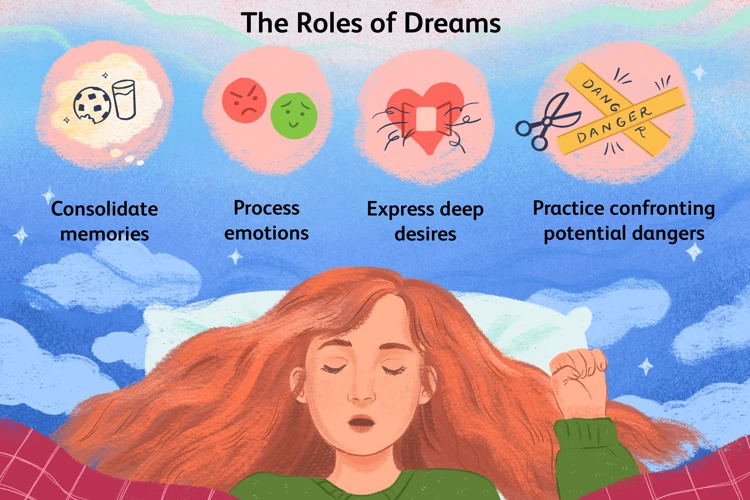Dreams have always fascinated and puzzled us, as they often contain a rich tapestry of symbols and images that can seem bewildering and mysterious. Interpreting these dream symbols is a complex task that requires careful consideration of various factors, especially the context in which they appear. The importance of context cannot be overstated, as it holds the key to unlocking the true meaning behind these symbolic messages from our subconscious mind. In this article, we will delve into the world of dream symbols and explore why context is crucial in deciphering their significance. By understanding the contextual clues and analyzing personal experiences and emotions, we can gain valuable insights into our dreams and gain a deeper understanding of ourselves. So, let us embark on this intriguing journey of decoding dream symbolism and unraveling the hidden messages within.
The Basics of Dream Symbols

|
What are Dream Symbols? Dream symbols are the images, objects, people, or scenarios that we encounter during our dreams. These symbols can vary widely and may hold different meanings for each individual. They can range from everyday objects to fantastical creatures, from familiar places to unknown landscapes. Dream symbols serve as a means of communication from our subconscious mind, offering us insights into our thoughts, emotions, and experiences. |
|
Why Do We Dream in Symbols? Dreaming in symbols is a natural and intrinsic part of the dreaming process. Our dreams often operate in a symbolic language because our subconscious mind communicates in abstract and metaphorical ways. Symbols in dreams allow our subconscious to convey deeper meanings and messages that may be difficult to express through direct and literal language. Symbols can act as a bridge between the conscious and unconscious mind, helping us access and understand aspects of ourselves that may be hidden or repressed. |
|
Common Dream Symbols and Meanings While dream symbols can vary greatly between individuals, there are certain symbols that are commonly experienced and can have shared meanings. Examples of common dream symbols include falling, flying, being chased, water, animals, and death. However, it is important to note that the interpretation of these symbols can differ depending on the individual’s personal experiences, cultural background, and emotional state. It is crucial to consider the context and personal associations with each dream symbol for a more accurate interpretation. |
What are Dream Symbols?
Dream symbols are the metaphorical images, objects, characters, or scenarios that populate our dreams. When we dream, our subconscious mind utilizes symbols to communicate with us in a language that is different from our waking, logical mind. These symbols can take various forms, such as a flying bird, a broken mirror, or a crowded marketplace. Each dream symbol carries its own unique meanings and interpretations, which can be highly subjective. The interpretation of dream symbols is not an exact science and can vary depending on personal experiences and cultural influences. It is important to approach dream symbolism with an open mind and consider the context of the dream as well as any personal associations we may have with the symbols. By delving into the world of dream symbolism, we can gain valuable insights into our inner selves and unlock the hidden messages that our subconscious mind is trying to convey. For a deeper understanding of dream symbolism and its interpretation, you can explore the guide on “Unlocking Symbolism in Dream Interpretation”.
Why Do We Dream in Symbols?
Dreaming is a complex and fascinating phenomenon that serves various psychological purposes, including processing emotions, consolidating memories, and problem-solving. One of the intriguing aspects of dreaming is the use of symbols. But why do we dream in symbols? It is believed that dreams use symbolism as a way to communicate complex and abstract ideas that may be difficult to express through literal representation. Symbols allow our subconscious mind to convey deeper meanings and connect disparate ideas. They can act as a bridge between our conscious and unconscious mind, helping us tap into the depths of our psyche. By exploring dream symbols, we can unlock the hidden messages and insights from our subconscious, gaining a deeper understanding of ourselves and our experiences. If you’re interested in learning more about the power of dream symbolism and how to interpret them, you can check out this article on unlocking the symbolism in dream interpretation. Understanding the significance of symbols in dreams can provide valuable insights into our innermost thoughts, emotions, and desires.
Common Dream Symbols and Meanings
Common dream symbols can provide valuable insights into our subconscious mind and offer a glimpse into our deepest thoughts and emotions. However, it is important to remember that dream symbols can have different meanings for different individuals. Here are a few examples of common dream symbols and their potential interpretations:
- Falling: Falling in a dream can symbolize a lack of control, fears of failure, or a sense of insecurity. It may also represent a need to let go of something or take a leap of faith.
- Flying: Flying in a dream often symbolizes freedom, liberation, and a sense of empowerment. It may also indicate a desire to escape or rise above challenges or constraints.
- Being Chased: Being chased in a dream can reflect feelings of anxiety, fear, or avoidance. It may suggest that there is something in your waking life that you are trying to avoid or confront.
- Water: Water in dreams is often associated with emotions and the unconscious mind. The state of the water, whether calm or turbulent, can indicate the emotional state of the dreamer. It may also represent purification, change, or the flow of life.
- Animals: Animals in dreams can have a range of meanings depending on their characteristics and associations. For example, a snake may symbolize transformation or hidden fears, while a cat can represent independence or intuition.
- Death: Dreams about death do not necessarily indicate literal death, but rather symbolize endings, transitions, or the need for transformation. It can signify the release of old patterns or beliefs to make way for new beginnings.
Remember, these interpretations are not universal and may not apply to every dreamer. It is important to consider your personal associations, emotions, and experiences with each symbol. By exploring the meanings of common dream symbols, you can gain deeper insights into your subconscious mind and use this knowledge to better understand yourself and your waking life.
The Role of Context in Dream Interpretation

|
Understanding the Contextual Factors The context in which dream symbols appear plays a crucial role in their interpretation. Context refers to the surrounding elements, events, emotions, and personal experiences within the dream. It provides valuable clues that help us decipher the meaning behind the symbols. When analyzing the context, consider the specific details such as the setting, people involved, actions taking place, and the overall mood of the dream. These contextual factors can shed light on the underlying message being conveyed by the dream symbols. |
|
How Context Shapes Dream Symbolism Context plays a significant role in shaping the symbolism of dream elements. For example, a dream about water may have different meanings depending on whether it appears as a calm lake or a turbulent ocean. The feelings associated with the water, such as relaxation or fear, can further influence the interpretation. Similarly, the presence of certain individuals in the dream, such as a family member or a stranger, can alter the symbolism based on the relationship and emotions tied to them in waking life. Analyzing the context helps paint a more accurate picture of the intended message behind the dream symbols. |
|
Examining Personal Context Personal context is an essential aspect of dream interpretation. Our own unique experiences, memories, and beliefs shape the way dream symbols are perceived. Factors such as past traumas, current circumstances, and personal goals can all contribute to the symbolism within a dream. It is crucial to reflect on personal associations and emotions triggered by the dream symbols in order to gain a deeper understanding of their meaning in relation to our own lives. |
|
Examining Cultural and Historical Context Cultural and historical influences also impact the interpretation of dream symbols. Different cultures may assign specific meanings and symbolism to certain objects or events in dreams. For example, a white cat may be seen as a sign of good luck in one culture, while it may carry negative connotations in another. Historical context can also shape the symbolism of certain dream elements, as societal beliefs and practices evolve over time. By considering the cultural and historical context, we can gain additional insights into the meaning of dream symbols. |
Understanding the Contextual Factors
Understanding the contextual factors surrounding dream symbols is essential for accurate interpretation. Context refers to the specific circumstances, events, and emotions that surround the dream symbol. By analyzing the context, we can gain deeper insights into the symbolism and its significance. Contextual factors may include the overall theme of the dream, the emotions experienced during the dream, the people or objects present in the dream, and the actions or events unfolding within the dream. Examining the context helps us make connections between the symbol and our waking life experiences, allowing us to uncover the underlying messages and meanings. For example, if we dream of flying while experiencing a sense of freedom and joy, it may indicate a desire for liberation or breaking free from constraints in our waking life. By paying attention to the contextual factors, we can uncover valuable clues that guide us towards a more comprehensive understanding of our dreams.
How Context Shapes Dream Symbolism
Context plays a pivotal role in shaping dream symbolism and understanding the true meaning behind dream symbols. The context of a dream refers to the surrounding circumstances, events, emotions, and personal experiences that occur within the dream. By analyzing the context, we can gain valuable insights into the specific message that our subconscious is trying to convey through the symbols we encounter.
For example, if someone dreams of a snake, the interpretation of that symbol can vary greatly depending on the context. If the dreamer has a fear of snakes and feels threatened or anxious in the dream, the snake may represent a hidden fear or a sense of danger in their waking life. However, if the dreamer has a positive association with snakes or sees the snake in a peaceful and calm context, it may symbolize transformation or healing.
Context also extends beyond the individual dreamer. Cultural and historical context can influence the interpretation of dream symbols. Symbols that hold specific cultural or historical significance may carry different meanings across different societies or time periods. For instance, a dream about a white dove may be seen as a symbol of peace in one culture, while in another culture, it may represent love or spiritual enlightenment.
To fully understand how context shapes dream symbolism, it is essential to consider the personal, cultural, and historical factors that contribute to the meaning of each symbol. By delving into the specific details of the dream context, we can unlock a deeper understanding of our dreams and gain valuable insights into our subconscious mind. For more information on the power of dreams and their connection to future events, please check out this article.
Examining Personal Context
|
When interpreting dream symbols, it is crucial to consider the personal context of the dreamer. Personal context refers to the unique experiences, beliefs, and emotions of the individual. To examine personal context, one must reflect on their own life circumstances, relationships, and current challenges. For example, if someone dreams of a snake, the interpretation may be different for someone with a fear of snakes compared to someone who views snakes as symbols of transformation and rebirth. Consideration of personal associations and individual perspectives is essential in uncovering the meaning behind dream symbols. |
|
The Role of Emotions Emotions play a significant role in personal context when interpreting dream symbols. Our emotions can amplify or alter the meaning of symbols within our dreams. For instance, if someone dreams of flying and feels exhilarated, it may indicate a sense of freedom and empowerment in their waking life. On the other hand, if flying induces anxiety and fear, it could represent a fear of losing control or taking risks. Understanding the emotional responses to dream symbols helps to unravel the subconscious messages and shed light on inner conflicts or desires. |
|
The Influence of Daily Experiences Daily experiences and events can significantly impact the personal context of dream symbols. Our dreams often reflect ongoing situations or recent interactions that hold emotional or psychological significance. For example, if someone dreams of being late for an important meeting, it may stem from the stress and pressure they are experiencing in their professional life. Examining personal context involves reflecting on recent events, identifying connections, and analyzing how these experiences shape the symbolism within the dream. |
By taking into account personal context, including emotions and daily experiences, individuals can gain deeper insights into the meaning behind their dream symbols. Understanding the interplay between personal context and dream symbols allows for a more nuanced interpretation and offers valuable guidance for personal growth and self-reflection.
Examining Cultural and Historical Context
|
Cultural and historical context play a significant role in the interpretation of dream symbols. Different cultures and time periods may have unique symbolism and associations attached to certain objects or scenarios. For example, a snake may be seen as a symbol of wisdom and transformation in one culture, while in another culture it may represent deceit or danger. Understanding the cultural context can help shed light on the intended meaning of specific symbols in dreams. Similarly, historical context can also influence the interpretation of dream symbols. Events or experiences that were prevalent during a particular era may manifest as symbols in dreams. Historical events, cultural movements, and even popular media can leave lasting imprints on our subconscious mind, shaping the symbolism we encounter in our dreams. It is important to research and consider the cultural and historical context applicable to dream symbols, especially if they appear to be obscure or unfamiliar. By examining these external influences, we can gain a broader understanding of the potential meanings behind the symbols in our dreams. |
Interpreting Dream Symbols with Contextual Clues

Recognizing Repeating Symbols
One effective way to interpret dream symbols is by paying attention to any repeating symbols that occur in your dreams. Repeating symbols often indicate the importance and significance of a particular symbol in your life. Take note of any symbols that appear frequently, as they may represent recurring themes, lessons, or unresolved emotions in your waking life. Analyzing the patterns and variations within these symbols can provide valuable insights into their meaning and the messages your subconscious mind is trying to convey.
Considering the Surrounding Dream Events
Another crucial aspect of interpreting dream symbols is considering the surrounding dream events. Dreams often present a sequence of events, and the context in which a specific symbol appears can greatly influence its interpretation. For example, dreaming of flying while feeling joy and freedom may symbolize a sense of empowerment and success, whereas dreaming of flying while feeling fear and anxiety could represent a feeling of being overwhelmed or out of control. By analyzing the emotions, actions, and events that occur alongside a particular symbol, you can gain a deeper understanding of its meaning and how it relates to your current circumstances.
Exploring Feelings and Emotions
When interpreting dream symbols, it is essential to explore the feelings and emotions associated with them. The emotions experienced in a dream can provide valuable clues about the symbol’s meaning in your waking life. Consider how you felt during the dream—were you happy, scared, sad, or excited? These emotional responses can offer insights into subconscious desires, fears, or unresolved issues. By examining the emotional context of a dream symbol, you can unravel the deeper layers of its significance and better understand its relevance to your personal experiences.
Analyzing Personal Experiences and Life Situations
Analyzing personal experiences and life situations is paramount when interpreting dream symbols with contextual clues. Dreams are highly individualized, and symbols hold different meanings based on personal associations. For instance, while a snake may commonly symbolize transformation or fear, if you have a positive association with snakes due to a personal experience, the symbol can represent healing or renewal for you specifically. Reflecting on your own life situations, memories, and beliefs can shed light on the unique interpretation of dream symbols and help you make connections to your conscious life.
Remember, dream interpretation is a deeply personal practice, and there is no one-size-fits-all approach. The power lies in your ability to connect with your subconscious mind and understand the symbolism within the context of your life. By honing your awareness of repeating symbols, examining the surrounding dream events, exploring emotions, and analyzing personal experiences, you can unlock the profound insights hidden within your dreams.
Recognizing Repeating Symbols
Recognizing repeating symbols in dreams is a crucial aspect of dream interpretation. When a symbol repeats itself throughout multiple dreams or within a single dream, it signifies the importance and significance of that symbol. These repeating symbols often carry a deeper message or meaning that the subconscious is attempting to convey. By paying attention to these recurring symbols, dreamers can gain insights into persistent themes, emotions, and unresolved issues in their lives.
For example, if a dreamer regularly dreams about being chased by an unknown figure, it could indicate a sense of fear or anxiety that is present in their waking life. The repetition of this symbol suggests that the dreamer needs to confront and address this underlying fear. Alternatively, a recurring symbol such as a butterfly can symbolize transformation, growth, and freedom. Seeing this symbol repeatedly may indicate that the dreamer is going through a period of personal growth and positive change.
To effectively recognize and interpret these repeating symbols, it is essential to keep a dream journal. By recording dreams and noting down any recurring symbols or themes, patterns may emerge over time. This practice enables the dreamer to identify the specific symbols that warrant further exploration and analysis. Additionally, keeping track of the emotions, events, and circumstances surrounding the dreams can provide valuable contextual information for a more accurate interpretation.
Understanding the significance of repeating symbols in dreams can provide valuable insights into our subconscious mind and assist in personal growth and self-discovery. By unraveling the hidden messages within these symbols, we can gain a deeper understanding of ourselves and navigate our waking lives with greater awareness and clarity.
Considering the Surrounding Dream Events
When interpreting dream symbols, it is crucial to consider the surrounding dream events. The events that unfold in a dream can provide important contextual clues that help to shed light on the meaning of the symbols present. For example, if someone dreams of being chased by a mysterious figure through a dark forest, the presence of fear and danger in the dream events can influence the interpretation of the symbols. The dreamer may be experiencing feelings of anxiety or a sense of being pursued in their waking life, which can be reflected in the dream scenario. Conversely, if the dream events are positive and joyful, it may indicate that the symbols carry a more optimistic meaning. Analyzing the sequence and progression of events in a dream can offer valuable insights into the underlying emotions and themes at play. By understanding the relationship between the symbols and the dream events, we can unlock a deeper understanding of our dreams and their connection to our waking lives. To enhance this understanding further, individuals can explore the power of lucid dreaming, which allows them to be aware and in control of their dreams.
Exploring Feelings and Emotions
When interpreting dream symbols, exploring the feelings and emotions associated with them is crucial. Our dreams often elicit strong emotional responses, and these feelings can provide valuable insights into the meaning behind the symbols. For example, if you dream of flying and feel exhilaration and freedom, it could indicate a sense of liberation or empowerment in your waking life. On the other hand, if you experience fear or anxiety during the flying dream, it may represent feelings of insecurity or a fear of not being in control. By paying attention to the emotions evoked by dream symbols, we can gain deeper understanding of our subconscious desires, fears, and unresolved issues. Additionally, it is important to consider how these emotions relate to our waking life experiences. Are there any parallels or connections between the dream emotions and our current situation or relationships? Exploring the emotional landscape of our dreams can provide significant clues to their underlying meanings and help us gain greater self-awareness. The power of lucid dreaming can further enhance our ability to explore and control our dream emotions, providing us with even more valuable insights into ourselves and our dreams.
Analyzing Personal Experiences and Life Situations
Analyzing personal experiences and life situations is a key aspect of interpreting dream symbols. Our dreams reflect our inner thoughts, emotions, and experiences, so examining our personal context is essential for unraveling their meaning. One approach is to consider any recent or significant events that may have influenced our dreams. For example, if we have been experiencing stress at work, we may have dreams related to work-related symbols such as deadlines or conflicts with colleagues. It’s also crucial to reflect on our own emotions and feelings within the dream. Our emotions can provide valuable insights into the significance of certain symbols. For instance, if we feel fear or anxiety in a dream where we encounter a snake, it could suggest that we are facing hidden fears or potential threats in our waking life. Additionally, exploring our life situations, relationships, and aspirations can offer deeper interpretations of dream symbols. The key is to delve into our personal context and draw connections between our dreams and our waking experiences to uncover the hidden messages they hold.
Common Pitfalls in Interpreting Dream Symbols
- Overlooking Contextual Factors: One common pitfall in interpreting dream symbols is the tendency to focus solely on the individual symbols themselves, without considering the broader context in which they appear. Dreams are complex and layered, and each element within a dream can influence the meaning of other symbols. By overlooking the contextual factors such as the setting, characters, and emotions in the dream, we risk missing important connections and nuances in the interpretation.
- Using Generic Universal Symbolism: Another common mistake is relying too heavily on generic or universal meanings assigned to dream symbols. While certain symbols may have generally accepted interpretations, it is essential to remember that personal associations and cultural influences play a significant role in shaping the symbolism of dreams. Using generic symbolism without taking into account personal context can lead to inaccurate interpretations.
- Ignoring Personal Associations: Each person has unique experiences, memories, and associations attached to certain symbols. Ignoring these personal associations when interpreting dream symbols can result in a shallow and incomplete understanding of the dream’s message. It is important to consider how specific symbols resonate with our individual lives and what they may represent to us personally.
Overlooking Contextual Factors
One common pitfall in interpreting dream symbols is overlooking the contextual factors that surround them. Context is crucial in understanding the true meaning behind a symbol, as symbols can vary in interpretation depending on their surrounding events and circumstances. Failing to consider the context can lead to misinterpretation and a shallow understanding of the dream. When analyzing a dream, it is important to take note of the setting, the people or objects present, and the overall atmosphere or mood of the dream. All these contextual factors can provide valuable insights into the symbolism at play. For example, dreaming about a snake in a peaceful garden may have a different meaning than dreaming about a snake in a dark and dangerous forest. Understanding the contextual factors allows us to delve deeper into the symbolism and uncover the hidden messages that our subconscious is trying to convey.
Using Generic Universal Symbolism
|
One common pitfall in interpreting dream symbols is relying solely on generic universal symbolism. These are widely accepted meanings for symbols that can be found in dream interpretation books or online resources. While these interpretations may provide some general insights, they often fail to consider the specific context and personal associations of the dreamer. Dreams are highly personal and subjective, and their symbols can hold unique meanings for each individual. It is essential to go beyond generic interpretations and explore the personal significance of the symbols within the dream. |
Ignoring Personal Associations
|
One common pitfall in interpreting dream symbols is overlooking the importance of personal associations. Each individual has a unique set of experiences, memories, and emotions that shape their perception of the world. When analyzing dream symbols, it is crucial to consider the personal significance and associations attached to these symbols. For example, while a snake may commonly symbolize transformation or hidden fears, for someone who has a positive association with snakes due to a childhood pet, the meaning could be entirely different. By ignoring personal associations, we risk misinterpreting the true message that our subconscious mind is trying to convey. |
Conclusion
|
In conclusion, interpreting dream symbols requires a deep understanding of the importance of context. Dream symbols are the language of our subconscious mind, offering us valuable insights and messages about ourselves and our lives. By considering the contextual factors such as personal experiences, emotions, and cultural influences, we can unlock the true meaning behind these symbols and gain a deeper understanding of ourselves. It is important to avoid common pitfalls such as overlooking contextual factors, relying on generic symbolism, and ignoring personal associations. Instead, we should focus on recognizing repeating symbols, considering the surrounding dream events, exploring our feelings and emotions, and analyzing our personal experiences and life situations. |
Frequently Asked Questions
Can dream symbols have different meanings for different people?
Yes, dream symbols can have different meanings for different individuals. Personal experiences, cultural background, and emotional state play a significant role in how dream symbols are interpreted.
Are there universal dream symbols with fixed meanings?
While there are certain symbols that are commonly experienced, such as falling or flying, the interpretation of dream symbols is not fixed or universal. Context and personal associations are crucial in determining the meaning of a dream symbol.
Do dream symbols always have a hidden or symbolic meaning?
Not always. Sometimes, dream symbols can be a reflection of recent events, thoughts, or experiences and may not carry a hidden or symbolic meaning.
Can dream symbols predict the future?
Dream symbols themselves do not predict the future. However, dreams can provide insights into our subconscious thoughts and emotions, which can indirectly influence our future actions and decisions.
Can dream symbols be influenced by external factors?
Yes, external factors such as media, books, or personal beliefs can influence the appearance and meaning of dream symbols. It is important to consider both internal and external factors when interpreting dream symbols.
Is it possible to control or manipulate dream symbols?
Through practices like lucid dreaming, individuals can gain some control over their dream symbols and manipulate them. Lucid dreaming allows you to become aware that you are dreaming, giving you the ability to consciously change or interact with dream elements.
Can dream symbols recur in multiple dreams?
Yes, dream symbols can recur in multiple dreams. Repeating symbols may indicate unresolved issues or important messages from the subconscious that need attention and reflection.
How can I analyze the personal context of a dream symbol?
Analyzing the personal context of a dream symbol involves considering your own experiences, emotions, and thoughts related to the symbol. Reflecting on how the symbol makes you feel and any personal associations you have with it can provide insights into its meaning for you.
Why is the interpretation of dream symbols subjective?
The interpretation of dream symbols is subjective because it relies on individual experiences, emotions, and beliefs. What may hold a specific meaning for one person could have a completely different meaning for another.
Should I consult a professional for help with dream symbol interpretation?
If you are struggling to interpret the meaning of your dream symbols, seeking the guidance of a professional, such as a therapist or dream analyst, can be beneficial. They can provide additional insights and help you navigate the complexities of your dreams.









